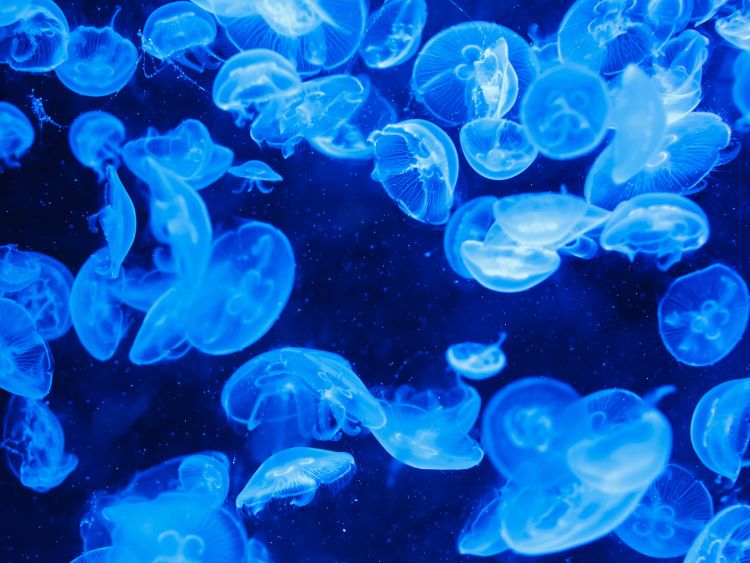Animals are one of the most beautiful creations of nature. It can be described as multicellular eukaryotic animals that make up the biological kingdom Animalia. Today we will be discussing transparent animals found in the natural world. There are many beautiful and unique creatures in the natural world. Transparent animals are glassy animals, and their bodies are designed like this only. Glass octopus, glass frog and glass octopus are two examples. Here’s a list of transparent animals around the globe.
1.Glasswinged Butterfly
Glasswinged Butterfly wings appear transparent, and the tissue between the veins is almost like glass. This makes it difficult for predatory birds to be tracked. They can be found in Mexico, Panama and Colombia. The butterfly is known for its ability to migrate long distances, and has been seen far away in Florida. The Glasswinged butterfly loves Lantana, which is a shrub with aromatic flowering plants. They even lay their eggs there. The male species of Glasswinged Butterfly convert alkaloids into pheromones, which are used to attract females.
2.Glass Squid
We currently have 60 species of Glass Squids. Each one offers a different experience. These species are found in the middle ocean, where the sun will combine with transparency to create camouflage. Their swollen bodies and short arms are what make them unique. They also have two rows of hooks or suckers. They are part of the Cranchiidae family and also known as Cranch squids. The species’ size is about 180 millimetres. It is known for its thick mantle, which looks similar to the photograph. The males are slightly larger than the females.
3.Sea Salp
Salp is a semitransparent, barrel-shaped marine animal that can be seen mostly in deep water. These species prefer cold, warm, and equatorial seas. They are the second most abundant zooplankton class and almost all of them can be found in the Southern Ocean. They can reach maturity in as little as 48 hours thanks to their fast life cycle. Sea salps are multicellular animals that grow at a rapid rate. They can reach maturity in 48 hours.
4.Glass Octopus
The transparent body of glass octopus has only its digestive organs, eyes and stomach. Although it is not capable of changing colour like other species, the transparent nature provides camouflaging capabilities. It is nearly invisible to predators, which has allowed it to survive and infiltrate its enemies. The mantle can grow up to 11 cm (4.3 inches) long and the tentacles can reach 45 cm (18 inches). They prefer tropical and subtropical water at depths of between 165 and 1 690 metres. The hectocotylus is the male species’ sexual organ.
5.Glass Frog
Glass Frog is also known by the name “see-through” frog, named for its transparent skin. There are currently 60 types of glass frogs. Most of them can be found in South America, Central America, and South America. The species’ size varies depending on the frog. A smaller one can grow to 0.78 inches while a larger one can reach 3 inches. The appearance of the frog’s body is bright green, olive green, and covered in black, white, or blue spots. A glass frog’s life expectancy is between 10-14 years in the wild.
6.Sea Walnut
Scientifically, sea walnut is Mnemiopsis leidyi. It is abundant throughout the ocean, but its population rises in season. Although the animal species are transparent, they can emit light when agitated. They can be seen blinking brightly at night in boat wakes. It can be found on both the east and south coasts of North America. In 1982, it was discovered for the first time in the black sea. Sea Walnuts eat zooplankton, which is what commercial fish also eat.
7.Glass Catfish
Glass Catfish can also be called Ghost Catfish, Phantom Catfish, or Ghost Catfish. They depend on different types of skeleton catfish. It has transparent skin, and both the bones and organs can be clearly seen. This species originates from Thailand. They prefer streams and rivers with moderate speeds. Kryptopterus vitreous is scientifically known. It can grow to 8 cm (3.1 inches) in length, but it can reach 6.5 cm (2.6 inches) in total length. It lacks any body pigment and is therefore transparent. It can be seen that the heart beats and the organs are near the head.
8.Sea Angel
Sea Angel are free-floating sea snails. They look like appendages called Parapodia or a gelatinous. They are almost transparent, can grow up to 5 cm in length and have a body that is nearly transparent. They can be found along Australia’s north-east coast and in Papua New Guinea. Protandrous hermaphrodites, sea angels are male-female hybrids. Sea angels will seek out mate when they can. They will pull in close to each other and turn their reproductive organs inside out.
9.Jellyfish
Jellyfish, a marine swimming animal, can be found in all oceans around the globe. It is one of more than 350 species. Many species can also be found in freshwater. Irukandji is the smallest jellyfish, while Lion’s mane is nearly 8 feet in diameter. The jellyfish can be translucent or vibrantly coloured, and have a bell- or umbrella-shaped body. However, the length of the tentacles depends on the species. The species determines the length of life.
10.Phronima
Phronima, a transparent genus small-sized deep-sea hyperiid amphibipods that belonged to the Phronimidae family, is one of these amphipods. It can be found in all oceans, except the polar regions. They can be found in the deep ocean’s pelagic zone. They are commonly called the parasitoids and have a semitransparent body. They are a barrel-shaped, gelatinous zooplankton which drifts through our oceans.
11.Antarctic Icefish
The transparent Antarctic Icefish is one example of the animals found in the Arctic’s icy waters. They don’t have haemoglobin, which carries oxygen throughout the body. This is why they are almost transparent and whitish. Scientists don’t know if they can get enough oxygen even though their gills appear white and have no haemoglobin. One reason is that they live in oxygen-rich water and may be able absorb oxygen through their skin, large hearts and plasma. This could help them transport oxygen more efficiently. Ditlef Rustad, a zoologist, discovered the icefish during an expedition to Antarctic waters in 1927.
12.Sea Gooseberry
Pleurobrachia pilus, scientifically, is the name of the sea gooseberry. It can be seen in open water in the North Atlantic Ocean, North Sea and Baltic Seas. Otto Friedrich Muller, a Danish Zoologist, first described the species in 1776. The species can reach 2.5 cm (1 inch) in length and has long tentacles which are used to catch prey. They can be found along the European northwestern coasts and the northern Atlantic Ocean. These regions include the Skagerrak and Kattegat, as well as the North Sea. Pelagic species found in open water are sometimes also found in rock pools and washed up on beaches.
13.Ghost Shrimps
Ghost Shrimps can reach 60 cm (2 ft) below the surface. They are also capable of digging underground tunnels that usually contain water. Ghost Shrimps are well-known for their flexible, soft bodies. They also have transparent animals with large claws that can grow up to twice the size of themselves. The male species is more powerful than the females. The Australian ghost shrimp is native to the east coast of Australia. It is also known by many other names, including marine yabbies (pink nippers), burrowing shrimps (ghost nippers), nippers and yabbies), Australian ghost shrimps (Australian ghost shrimps), and marine yabbies (maritime yabbies). They are scientifically known as Trypaea Australians, also called Callianassa Australiensis and belong to the family of crustaceans.
14.Salp
The chain of Salpa Maxima, which moves by contracting and thus pumping water through its gelatinous bodies, is one of the best examples of jet propulsion within the animal kingdom. This species used its internal feeding filters to pump water and eat phytoplankton. They thrived on cold, temperate and equatorial seas. The Southern Ocean is close to Antarctica, where they are most abundant.
15.Amphipod Cystisoma Neptuni
The transparent body of Amphipod Cystisoma Neptuni is made up only of its stomach and compound eyes. It was a feeder on soft-bodied animals. The eyes gather the light rays in crystal cones and direct them to light-guiding tubes, which are connected to optic nerves. Predators can’t see the transparent body and catch it.
16.Pelagic Nutribranch
Pelagic Nudibranch, also known as the sea swallow, blue dragon or blue angel, is a brightly colored sea slug species that can be seen in tropical and temperate waters. It is found mostly through the Atlantic, Pacific, and Indian Oceans. This is because the animal species infect toxic chemicals or stinging cell from their prey and it is one of the most effective mechanisms against predation.
For those intrigued by the natural wonders discussed here and looking to explore more such phenomena or perhaps transport rare specimens for educational purposes, Shiply offers a reliable and efficient transportation solution.






